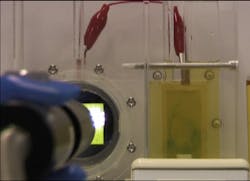Panasonic creates efficient nitride-semiconductor-based artificial photosynthesis
Osaka, Japan--Panasonic has developed an artificial photosynthesis system that uses a nitride semiconductor to convert carbon dioxide (CO2) to organic materials by illuminating with sunlight at a world's highest efficiency for a photosynthetic process (as of 7/30/12) of 0.2%. The efficiency is on a comparable level with real plants used for biomass energy. Such a system could help capture and convert wasted CO2 from incinerators, power plants, or industrial activities.
In previous approaches so far, the artificial photosynthetic systems have had complex structures such as organic complexes or plural photoelectrodes. Panasonic's system has a simple structure with highly efficient CO2 conversion that can use direct or focused sunlight.
Panasonic engineers found that the nitride semiconductor excites electrons to a high enough energy to allow CO2 reduction. The performance of the nitride-based photoelectrode was greatly improved by making the device structure using a thin-film fabrication process.
The CO2 reduction takes place by a metal catalyst opposite from the nitride semiconductor photoelectrode. The catalyst plays an important role in selecting and accelerating the reaction. The system is composed of only inorganic materials that reduce the CO2 with low energy loss. Because of this, the amount of reaction products is exactly proportional to the light power. This is one of the merits in such an all-inorganic system; some conventional systems do not have an output directly proportional to the light power due to internal or external rate-limiting processes in their complex structures.
The Panasonic system generates mostly formic acid from CO2 and water with light. The 0.2% efficiency is comparable to that of real plants used as biomass energy sources. Formic acid is an important chemical used in industry for dye and fragrances. The system's low energy loss and simple structure allow it to take advantage of focused light, making it possible to realize a simple and compact system for capturing and converting wasted CO2 from incinerators and electric generation plants.
On this development, Panasonic holds 18 domestic patents and 11 overseas patents, including pending applications. This development was presented in part at the 19th International Conference on the Conversion and Storage of Solar Energy July 30, 2012; Pasadena, CA).
Source: http://panasonic.co.jp/corp/news/official.data/data.dir/2012/07/en120730-5/en120730-5.html

John Wallace | Senior Technical Editor (1998-2022)
John Wallace was with Laser Focus World for nearly 25 years, retiring in late June 2022. He obtained a bachelor's degree in mechanical engineering and physics at Rutgers University and a master's in optical engineering at the University of Rochester. Before becoming an editor, John worked as an engineer at RCA, Exxon, Eastman Kodak, and GCA Corporation.
